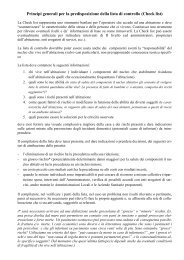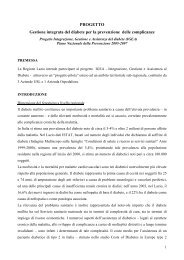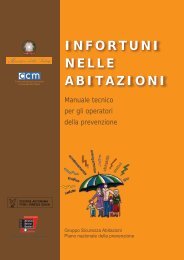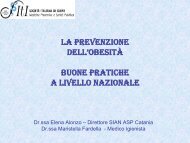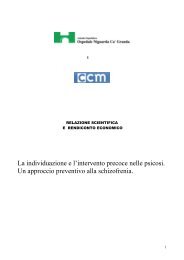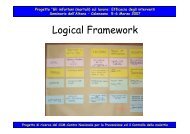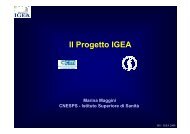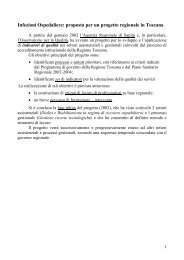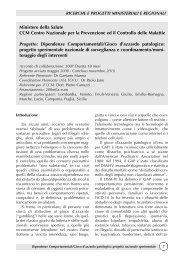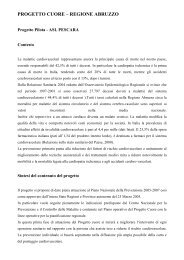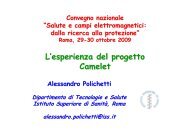Gaining health : analysis of policy development in European ...
Gaining health : analysis of policy development in European ...
Gaining health : analysis of policy development in European ...
Create successful ePaper yourself
Turn your PDF publications into a flip-book with our unique Google optimized e-Paper software.
Chapter 4<br />
56<br />
materials or to check on the use <strong>of</strong> such materials provided<br />
by food producers.<br />
In 1988, the Government appo<strong>in</strong>ted a multidiscipl<strong>in</strong>ary<br />
committee to prepare a national programme for coronary<br />
heart disease prevention, which dealt with food and nutrition<br />
among other topics. The National Nutrition Council<br />
prepared an action plan for the implementation <strong>of</strong> the food<br />
and nutrition aspects. What was particularly <strong>in</strong>terest<strong>in</strong>g <strong>in</strong><br />
relation to creat<strong>in</strong>g partnerships for <strong>health</strong> was that MSAH<br />
agreed that the National Nutrition Council would be more<br />
effective if the ma<strong>in</strong> control came from the M<strong>in</strong>istry <strong>of</strong><br />
Agriculture and Forestry. That M<strong>in</strong>istry chaired the Council<br />
and had the right to approve the names <strong>of</strong> its members.<br />
Fifty years later, this configuration still operates effectively,<br />
provid<strong>in</strong>g expert recommendations and guidel<strong>in</strong>es and<br />
act<strong>in</strong>g as an <strong>in</strong>tersectoral body to promote collaboration<br />
among various stakeholders. Furthermore, there was an attempt<br />
through negotiation to ensure acceptable trade-<strong>of</strong>fs<br />
for the various partners. For example, MHSA showed that<br />
the ga<strong>in</strong> <strong>in</strong> life expectancy, which would <strong>in</strong>crease the cost <strong>of</strong><br />
pensions and other benefits, could be counterbalanced by<br />
sav<strong>in</strong>g lives <strong>in</strong> “productive” age groups.<br />
New dietary recommendations were <strong>in</strong>troduced <strong>in</strong>1989 and<br />
goals were set for mass cater<strong>in</strong>g, which plays an important<br />
role <strong>in</strong> F<strong>in</strong>land. Perhaps <strong>in</strong>fluenced by the cold climate for<br />
much <strong>of</strong> the year, F<strong>in</strong>land has a strong tradition <strong>of</strong> provid<strong>in</strong>g<br />
hot meals <strong>in</strong> <strong>in</strong>stitutional sett<strong>in</strong>gs. S<strong>in</strong>ce the 1940s, free, hot<br />
school lunches have been provided to schoolchildren and<br />
today the great majority <strong>of</strong> 11–15-year-old schoolchildren<br />
report eat<strong>in</strong>g a meal <strong>in</strong> the school canteen every day. Some<br />
40% <strong>of</strong> economically active women and 35% <strong>of</strong> men eat a<br />
hot lunch at the workplace (42). Workplace canteens are<br />
supported by tax agreements and subsidies. By <strong>of</strong>fer<strong>in</strong>g<br />
models for <strong>health</strong>y eat<strong>in</strong>g, cater<strong>in</strong>g services have supported<br />
national dietary recommendations.<br />
The latest action plan was launched <strong>in</strong> 2003. While the<br />
role <strong>of</strong> the Government is ma<strong>in</strong>ly restricted to guidance<br />
and <strong>in</strong>formation, the role <strong>of</strong> municipalities and NGOs is<br />
emphasized. The F<strong>in</strong>nish Nutrition Recommendations were<br />
renewed <strong>in</strong> 2005, based on the latest Nordic Nutrition<br />
Recommendations approved <strong>in</strong> 2004 by the Nordic Council<br />
<strong>of</strong> M<strong>in</strong>isters. Recommendations on physical activity are also<br />
<strong>in</strong>cluded <strong>in</strong> the new version.<br />
Two issues are currently high on the agenda: the prevention<br />
<strong>of</strong> type 2 diabetes and obesity, particularly among children.<br />
The F<strong>in</strong>nish Diabetes Prevention Study, started <strong>in</strong> the late<br />
1990s, “was the first randomized study <strong>in</strong> the world to<br />
show that the onset <strong>of</strong> type 2 diabetes can be delayed and<br />
even avoided by lifestyle modifications among middle-aged<br />
<strong>in</strong>dividuals with impaired glucose tolerance” (43). Recommendations<br />
from this study have been <strong>in</strong>corporated <strong>in</strong> the<br />
National Programme for the Prevention and Care <strong>of</strong> Diabetes<br />
(DEHKO 2000–2010). The issue <strong>of</strong> obesity is becom<strong>in</strong>g<br />
so serious that one expert <strong>in</strong>terviewed considered that<br />
sugar might be the next target for taxation.<br />
One factor h<strong>in</strong>der<strong>in</strong>g the implementation <strong>of</strong> a strong<br />
nutrition <strong>policy</strong> is that the food <strong>in</strong>dustry is becom<strong>in</strong>g more<br />
northern <strong>European</strong> than F<strong>in</strong>nish. As F<strong>in</strong>nish firms export<br />
more products to the Baltic countries, for example, it<br />
becomes difficult to persuade them to accept restrictions<br />
with<strong>in</strong> F<strong>in</strong>land that are not necessarily required <strong>in</strong> other<br />
countries. On the other hand, F<strong>in</strong>land is also affected by<br />
what has been called the “wellness revolution” (44). One<br />
third <strong>of</strong> magaz<strong>in</strong>es refer to <strong>health</strong> issues, and particularly<br />
to nutrition and physical exercise. At the same time, the<br />
“wellness” market is burgeon<strong>in</strong>g, with functional foods to<br />
help manage specific diseases such as diabetes and arthritis<br />
or problems such as stress or low energy. There is a grow<strong>in</strong>g<br />
need to protect consumers from fraudulent claims and<br />
harmful products, so that knowledgeable consumers “can<br />
exercise choice <strong>in</strong> a highly unregulated <strong>health</strong> and wellness<br />
market” (45).<br />
Case studies: <strong>policy</strong> <strong>development</strong> <strong>in</strong> countries for tackl<strong>in</strong>g noncommunicable diseases



